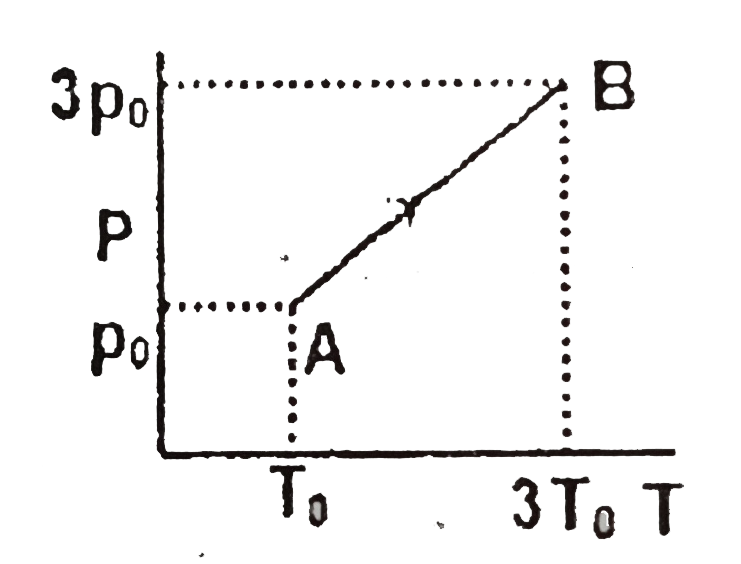16kg oxygen gas expands at STP to occupy double of its oxygen volume. The work done during the process is:
260 kcal
180 kcal
130 kcal
271 kcal
The correct Answer is:D
To solve the problem of calculating the work done during the expansion of 16 kg of oxygen gas at STP, we can follow these steps:
Step 1: Understand the Conditions at STP
At Standard Temperature and Pressure (STP), the temperature is 0°C (273 K) and the pressure is 1 atm.
Step 2: Determine the Molar Mass of Oxygen
The molar mass of oxygen (O₂) is calculated as follows:
- The atomic mass of oxygen is 16 g/mol.
- Therefore, the molar mass of O₂ = 16 g/mol × 2 = 32 g/mol.
Step 3: Calculate the Number of Moles of Oxygen
Using the formula for moles:
Number of moles=massmolar mass
Substituting the values:
Number of moles=16,000 g32 g/mol=500 moles
Step 4: Calculate the Initial Volume of Oxygen
At STP, 1 mole of gas occupies 22.4 liters. Therefore, the volume occupied by 500 moles is:
V1=500 moles×22.4 L/mole=11,200 L
Step 5: Determine the Final Volume After Expansion
The problem states that the gas expands to occupy double its initial volume:
V2=2×V1=2×11,200 L=22,400 L
Step 6: Calculate the Change in Volume
The change in volume (dV) is:
dV=V2−V1=22,400 L−11,200 L=11,200 L
Step 7: Calculate the Work Done
The work done (W) during the expansion at constant external pressure is given by:
W=−Pexternal×dV
Substituting the values:
W=−1 atm×11,200 L=−11,200 atm L
Step 8: Convert Work Done to Kilocalories
To convert atm L to kilocalories, we use the conversion factor:
1 atm L=24.22×10−3 kcal
Thus,
W=−11,200 atm L×24.22×10−3 kcal/atm L
Calculating this gives:
W=−271.3 kcal
Final Answer
The work done during the process is:
Work Done=−271.3 kcal
At Standard Temperature and Pressure (STP), the temperature is 0°C (273 K) and the pressure is 1 atm.
The molar mass of oxygen (O₂) is calculated as follows:
- The atomic mass of oxygen is 16 g/mol.
- Therefore, the molar mass of O₂ = 16 g/mol × 2 = 32 g/mol.
Using the formula for moles:
Number of moles=massmolar mass
Substituting the values:
Number of moles=16,000 g32 g/mol=500 moles
At STP, 1 mole of gas occupies 22.4 liters. Therefore, the volume occupied by 500 moles is:
V1=500 moles×22.4 L/mole=11,200 L
The problem states that the gas expands to occupy double its initial volume:
V2=2×V1=2×11,200 L=22,400 L
The change in volume (dV) is:
dV=V2−V1=22,400 L−11,200 L=11,200 L
The work done (W) during the expansion at constant external pressure is given by:
W=−Pexternal×dV
Substituting the values:
W=−1 atm×11,200 L=−11,200 atm L
To convert atm L to kilocalories, we use the conversion factor:
1 atm L=24.22×10−3 kcal
Thus,
W=−11,200 atm L×24.22×10−3 kcal/atm L
Calculating this gives:
W=−271.3 kcal
The work done during the process is:
Work Done=−271.3 kcal
Topper's Solved these Questions
- THERMODYNAMICSBOOK - AAKASH INSTITUTE ENGLISHCHAPTER - THERMODYNAMICSEXERCISE - ASSIGNMENT (Section - C) Previous Years Questions
60 Videos
- THERMODYNAMICSBOOK - AAKASH INSTITUTE ENGLISHCHAPTER - THERMODYNAMICSEXERCISE - ASSIGNMENT (Section -D) Assertion-Reason Type Questions
15 Videos
- THERMODYNAMICSBOOK - AAKASH INSTITUTE ENGLISHCHAPTER - THERMODYNAMICSEXERCISE - ASSIGNMENT (Section - A) Objective Type Questions
55 Videos
- THE SOLID STATE BOOK - AAKASH INSTITUTE ENGLISHCHAPTER - THE SOLID STATE EXERCISE - Assignment (SECTION - D) (ASSERTION-REASON TYPE QUESTION)
20 Videos
Similar Questions
Knowledge Check
An ideal gas system undergoes an isothermal process, then the work done during the process is
AnRTln(V2V1)BnRTln(V1V2)C2nRTln(V2V1)D2nRTln(V1V2)
The change in internal energy of two moles of a gas during adiabatic expansion is found to be -100 Joule. The work done during the process is
View SolutionThree samples A, B and C of the same gas (γ=1.5) have equal volumes and temperatures. The volume of each sample is doubled, the process being isothermal for A, adiabatic for B and isobaric for C. If the final pressures are equal for the three samples, Find the ratio of the initial pressures.
View Solution5 mole of an ideal gas of volume is expanded against vaccum to make its volume 2 times, then work done by the gas is:
View SolutionThe equation of a state of a gas is given by p(V−b)=nRT. If 1 mole of a gas is isothermally expanded from volume V and 2V, the work done during the process is
View SolutionAn ideal gas goes from the state i to the state ∫ as shown in .the work done by the gas during the process

View SolutionAn ideal gas has initial volume V and pressure p. In doubling its volume the minimum work done will be in the process (of the given processes)
View SolutionTwo moles of a monoatomic ideal gas undergoes a process AB as shown in the figure. Then, find the work done during the process in Joule.

View Solution
